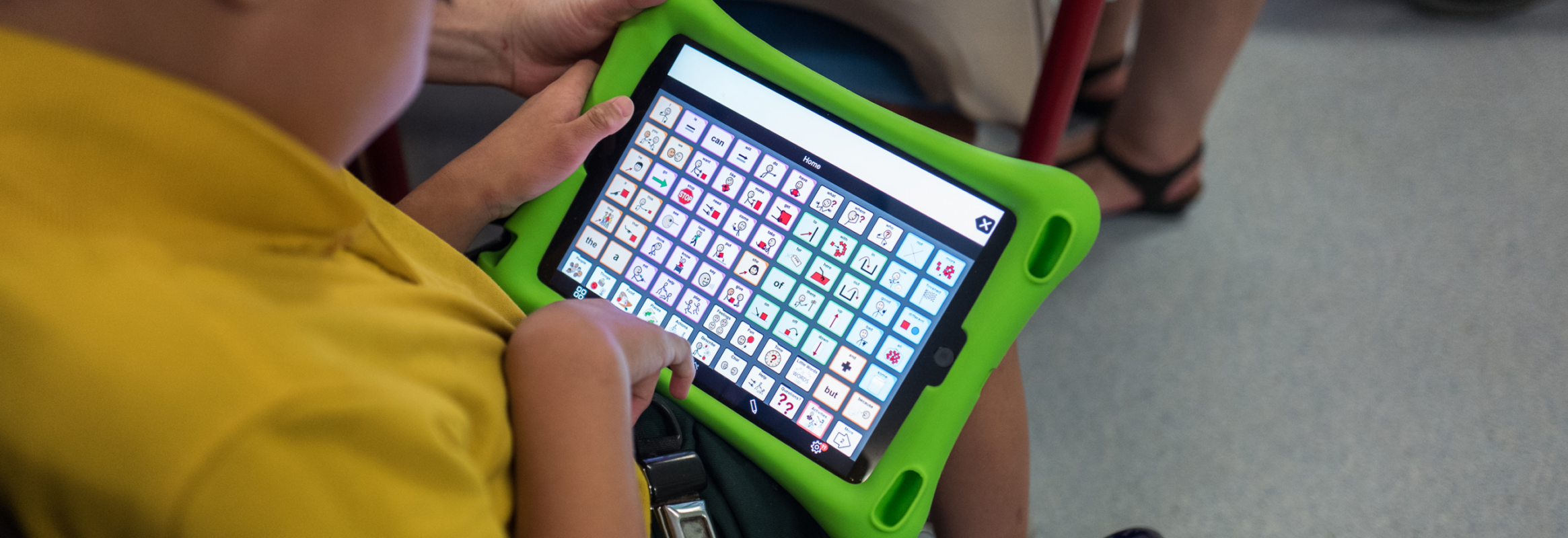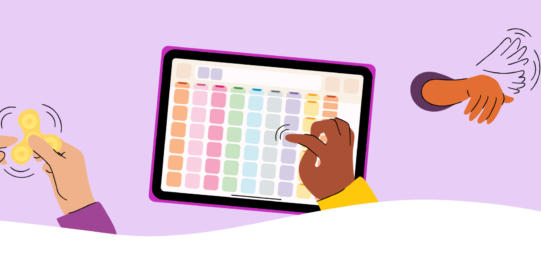Potential reasons for repetitive tapping:
1. Communication: Sometimes, repetitive button pressing is a direct attempt to communicate. If a person has a message to communicate but doesn’t know (or doesn’t have access to) all the words to say exactly what they mean, repetition of what they can say may be the best option. Maybe they haven’t been taught where to find the words they need, or their device doesn’t have them. They might not know how to connect the words to their experiences or are simply overwhelmed. The repetition could indicate frustration, excitement, or that their intended meaning has not yet been answered.
2. Device exploration: While we start forming the motor plan for a word in an AAC device very quickly, it takes far more repetitions before it becomes automatic to find that word when we need it. This is true for students, too. Just like people can repeat a word many times in a row when learning to say it or write it, students may repeat it many times in a row when learning to find it on their AAC. Tapping buttons over and over is the chance to explore words and their locations and get the repetitions they need to make it more automatic.
3. Language development: Repetition is a natural part of language learning. Some AAC users, especially those with auditory processing challenges, may tap buttons to hear the word multiple times and associate it with its meaning. Repeated tapping can mimic babbling or early stages of language development, where a person experiments with sounds and words to make sense of them. For AAC users who are gestalt language processors, repeating words can be part of breaking down large sentences that contain those words.
4. Stimming: For AAC users, repeatedly tapping a button can be a form of stimming. It may help them manage stress, excitement, or other emotional states. The repeated sound or sensation of pressing the same button can provide comfort or pleasure. In some cases, it might be a way for the user to express joy or cope with overstimulation. It’s important to recognize that stimming serves a vital function and should be supported rather than suppressed. If an AAC user is stimming to self-regulate because of a problem, like sensory overload, we should also try to address that root problem.
Practical ways to support repetitive tapping:
Now that we understand the potential reasons for repetitive tapping, it’s essential to approach it with strategies that support the AAC user rather than trying to make them stop. Trying to reduce repetitive communication leads to less communication overall — that’s not the result we want!
1. Assume it's communication: If you’re unsure whether the tapping is a communication attempt, treat it as if it is. Respond with statements like, “Do you mean…?” or “I think you’re saying…” and watch for their reaction. If they indicate that you’re wrong, make a new guess and adjust your response. Always assume that actions might be a form of communication and build on that. Also, look for possible connections between the repeated word and the current classroom/curriculum topic. If the class was looking at density with a sink-float test, “surfing” could be a question about how surfing works with density — people only barely float, but we’re almost entirely out of the water on a thin board when we surf!
2. Expand their language: When repetitive tapping involves specific words, use those words to expand on their ideas. If an AAC user repeatedly taps “surfing,” you might say, “Surfing is fun! Do you want to talk about a surfing trip?” This not only acknowledges the user’s input but helps enrich their language use.
3. Teach volume control and use of headphones: If the repetition is about communication, trying to reduce the extent to which people around the AAC user hear the repetition is counterproductive. For that reason, we should never enforce these options — what if it is an unrecognized or misunderstood communication attempt? However, headphones can let an AAC user explore their device, work on language skills, or stim without everyone around them hearing it. If they can connect or disconnect the headphones independently, they can even tell us whether or not a given message is one we should be responding to. If the AAC user can find a volume setting where they can hear their device, but others can’t, that has a similar effect to headphones.
4. Create spaces and times for device exploration: Encourage device exploration by offering dedicated moments for tapping or practicing. Let the user engage with the AAC without restrictions, reinforcing their learning of the system.
5. Support stimming: If the repetitive tapping is a form of stimming, it’s important to create an environment that welcomes and supports it. Some people will be happy for you to join in on certain kinds of stimming. Others may prefer acknowledgment without joining in - sometimes, a person stimming just needs to be left alone. Regardless, creating spaces or moments where stimming is encouraged can help AAC users feel safe and supported. Providing other sensory outlets, such as fidget tools or access to light-touch percussion instruments, can also complement their stimming needs.
6. Avoid removing or silencing the AAC device: Never take away the AAC device, mute it, or turn down its volume without the user’s consent. Doing so can deprive the user of their ability to communicate and cause emotional distress or trauma. The user’s tapping, whether for exploration, communication, or stimming, should not be treated as problematic behavior to be corrected or controlled.
Understanding the reasons behind repetitive button tapping helps build a supportive and empathetic learning environment for AAC users, promoting both language development and successful communication.





